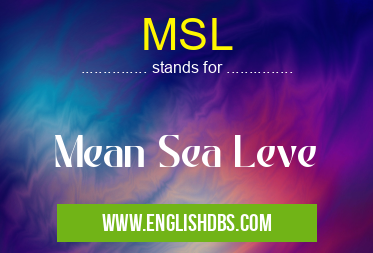What does MSL mean in GEOGRAPHY
MSL (Mean Sea Level) is a fundamental reference point used in various scientific and engineering applications, particularly in oceanography, surveying, and climate science. It serves as a benchmark for measuring the height of coastal features, tides, and sea level change. Understanding MSL and its significance is crucial in coastal management, environmental studies, and navigation.

MSL meaning in Geography in Academic & Science
MSL mostly used in an acronym Geography in Category Academic & Science that means Mean Sea Leve
Shorthand: MSL,
Full Form: Mean Sea Leve
For more information of "Mean Sea Leve", see the section below.
What does MSL Stand for?
Mean Sea Level is the average height of the sea's surface over a long period, typically calculated by averaging hourly water level measurements over 19 years. It is a dynamic value that varies over time and space due to factors such as tides, ocean currents, atmospheric pressure, and climate variability.
Significance of MSL
- Coastal Management: MSL is vital for determining the elevation of coastal landforms, such as beaches, dunes, and wetlands. This information is essential for planning coastal development, managing shoreline erosion, and assessing vulnerability to sea level rise.
- Navigation: MSL serves as a reference point for tide predictions and nautical charts. It helps mariners determine water depth and safe navigation routes, ensuring the efficient and safe operation of ships and boats.
- Oceanography: MSL is used in oceanographic studies to understand sea level variability, ocean circulation patterns, and the health of marine ecosystems. It provides insights into coastal processes, wave dynamics, and the impact of human activities on coastal environments.
- Climate Science: MSL is a critical indicator of climate change. Rising sea levels, caused by global warming and melting glaciers, can have severe consequences, including coastal flooding, erosion, and displacement of coastal populations. Monitoring MSL helps scientists track the long-term trend and predict future impacts.
Essential Questions and Answers on Mean Sea Leve in "SCIENCE»GEOGRAPHY"
What is Mean Sea Level (MSL)?
Mean Sea Level (MSL) refers to the average height of the ocean's surface over a long period, typically spanning several decades. It serves as a reference point for measuring changes in sea level due to factors such as climate change and land subsidence.
Why is MSL important?
MSL is crucial because it provides a baseline against which changes in sea level can be assessed. Rising sea levels can lead to coastal erosion, flooding, and other hazards that threaten coastal communities and ecosystems. Monitoring MSL is essential for understanding and mitigating the impacts of climate change on coastal regions.
How is MSL measured?
MSL is measured using a variety of methods, including tide gauges and satellite altimetry. Tide gauges are instruments that continuously record the height of the sea surface at specific locations. Satellite altimetry uses radar pulses from satellites to measure the distance between the satellite and the ocean surface, which can be used to derive sea level measurements.
Why does MSL vary?
MSL can vary over time due to several factors, including:
- Climate change: Rising temperatures cause thermal expansion of ocean water and melting of glaciers and ice caps, leading to increased sea levels.
- Land subsidence: The sinking of land, whether due to natural processes or human activities, can result in higher relative sea levels.
- Ocean currents: Changes in ocean currents, such as the El Niño-Southern Oscillation (ENSO), can cause temporary fluctuations in sea levels.
- Tides: The gravitational pull of the moon and sun creates tides, which are the regular rise and fall of the sea level.
Final Words: Mean Sea Level (MSL) is a fundamental concept in science, serving as a benchmark for measuring sea level, tides, and coastal elevation. It is crucial for coastal management, navigation, oceanography, and climate science. Understanding MSL and its variability is essential for addressing coastal challenges, ensuring safe maritime operations, and mitigating the impacts of climate change on our oceans and coasts.
MSL also stands for: |
|
| All stands for MSL |
